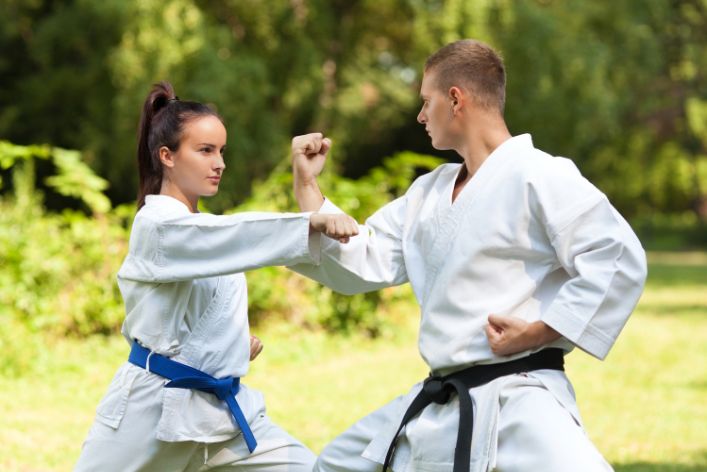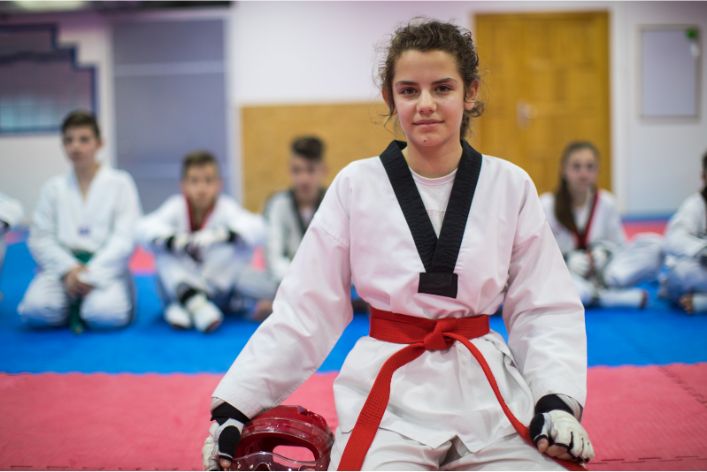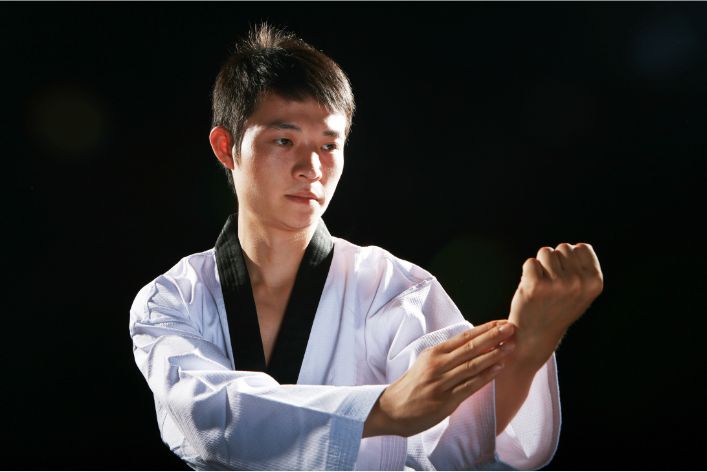Last Updated on May 29, 2023
In this blog post, we will delve into the intriguing topic of Jiu Jitsu vs. Other Martial Arts and explore what sets it apart. We aim to provide you with a clear understanding of the key differences between Jiu Jitsu and other popular martial arts forms. Jiu Jitsu has a rich history and is a complex art form with many techniques and strategies that distinguish it from other martial arts.

By understanding these unique qualities, readers can gain a greater appreciation for the art and potentially decide if Jiu Jitsu is the right martial art form for them. So continue reading as we break down the fundamentals of Jiu Jitsu and its distinguishing features compared to other martial arts.
Read: Essential Gear for Jiu Jitsu Training and Competition
History and Origins
Jiu Jitsu has a long and rich history, dating back to ancient Japan. Initially, it was practiced as a form of self-defense by Samurai warriors.
Over time, the techniques of Jiu Jitsu evolved and became more refined, with a greater emphasis on throws, joint locks, and submission holds.
When Japan’s feudal era came to an end, Jiu Jitsu slowly began to spread to other parts of the world, with practitioners traveling to observe and train with other martial arts practitioners.
In contrast to Jiu Jitsu’s ancient origins, many other martial arts such as Taekwondo, Karate, and Kung Fu have more recent histories, having emerged in the past few hundred years.
Read: Preparing for Your First Taekwondo Competition
Techniques and Philosophy
Jiu Jitsu is a highly technical martial art that emphasizes leverage and technique over brute strength. Rather than relying on striking or kicking techniques, practitioners of Jiu Jitsu focus on grappling and submission holds.
The philosophy of Jiu Jitsu is centered on the idea of using an opponent’s strength against them. By learning to control an opponent’s body and limbs, Jiu Jitsu practitioners can manipulate their opponent’s balance and leverage, making them vulnerable to submission.
Other martial arts, while also highly technical, may rely more on striking techniques. For example, Karate and Taekwondo both emphasize powerful kicks and punches, while Kung Fu emphasizes speed and agility.
Training and Competition
Training in Jiu Jitsu is often intense and demanding, with practitioners focusing on developing strength, balance, and flexibility. Jiu Jitsu practitioners also spend a lot of time learning specific techniques, such as throws and submission holds.
In terms of competition, Jiu Jitsu has become increasingly popular in recent years, with tournaments and competitions held around the world. Unlike many other martial arts, Jiu Jitsu competitions often allow for full-contact sparring, with participants grappling and submitting their opponents.
Other martial arts, in contrast, may place more emphasis on forms or “kata,” which are pre-arranged movements that students must master. Taekwondo, for example, has a series of “patterns” that students must learn and perform.
Jiu Jitsu is a unique and highly technical martial art that has a long and rich history. While it shares some commonalities with other martial arts, such as an emphasis on training and competition, its focus on grappling and submission sets it apart.
Whether you are looking to compete in tournaments or simply improve your fitness and self-defense skills, Jiu Jitsu offers an exciting and challenging path for practitioners of all levels.
Read: The Benefits of Jiu Jitsu for Mental and Physical Health
Philosophy and Techniques
When it comes to martial arts, there are a lot of options out there. From karate to kung fu, there are plenty of fighting styles to choose from depending on what you want to accomplish. One martial art that has gained a lot of popularity in recent years is Jiu Jitsu. But what sets it apart from other martial arts? Let’s take a closer look at the philosophy and techniques of Jiu Jitsu to find out.
Philosophy
- Jiu Jitsu is focused on leverage and technique rather than brute force.
- It emphasizes the idea that a smaller, weaker person can successfully defend themselves against a larger opponent.
- The goal of Jiu Jitsu is to gain a dominant position and then submit your opponent, rather than simply injuring them.
- It is a very strategic martial art that requires a lot of focus and mental agility.
- Jiu Jitsu also focuses on self-defense and practical combat situations rather than tournaments and competition.
Compared to other martial arts that may prioritize brute strength or flashy kicks and punches, Jiu Jitsu’s philosophy allows for a more sustainable practice that avoids injury and damage to both yourself and your opponent.
Techniques
- One of the key techniques in Jiu Jitsu is the use of joint locks and chokes.
- These are very effective in quickly gaining control over your opponent and forcing them to submit.
- There is also a strong focus on ground fighting in Jiu Jitsu, as it allows for more opportunities to use these techniques.
- Jiu Jitsu practitioners often spend a lot of time training in close range combat and grappling.
- Another unique aspect of Jiu Jitsu is its use of the gi, a traditional uniform that allows for a wide variety of grips and holds.
All of these techniques combined allow for a very effective and efficient style of self-defense that can be utilized in many different scenarios. The ability to quickly and effectively submit an opponent without causing unnecessary harm is a testament to the effectiveness of the philosophy and techniques of Jiu Jitsu.
Jiu Jitsu is a martial art that has a unique philosophy and set of techniques that set it apart from other options out there. Its focus on leverage and strategy over brute force means that it is a sustainable and effective way to defend yourself without causing harm to either yourself or your opponent. Its emphasis on ground fighting and use of the gi also add to its effectiveness and versatility. If you’re looking for a martial art that prioritizes practical self-defense and strategic thinking, Jiu Jitsu might be the perfect choice for you.
Read: How to Choose the Right Jiu Jitsu Academy for You
Training and Competition
One of the things that sets Jiu Jitsu apart from other martial arts is its training methods. Here’s an explanation of Jiu Jitsu training methods:
- Live sparring: In Jiu Jitsu, live sparring plays a central role in training. This means that practitioners regularly engage in full-contact, competitive training matches with partners. Unlike other martial arts that may focus more on forms or choreographed movements, Jiu Jitsu training is designed to simulate realistic combat scenarios.
- Focus on grappling: Jiu Jitsu is primarily a grappling-based martial art. This means that the majority of techniques are focused on takedowns, holds, and submissions that work on the ground. Training often involves drilling these techniques extensively.
- Emphasis on technique over strength: Jiu Jitsu places a strong emphasis on technique and leverage, as opposed to pure strength. This means that smaller practitioners can often defeat larger opponents by using proper technique and positioning.
When it comes to competitions, Jiu Jitsu also has some distinct differences from other martial arts. Here’s a comparison of Jiu Jitsu competitions to other martial arts competitions:
- Scoring system: In Jiu Jitsu competitions, points are awarded for takedowns, passing the guard, achieving dominant positions, and submitting opponents. This scoring system is unique to Jiu Jitsu and differs from the point systems used in other martial arts.
- Length of matches: Jiu Jitsu matches can often last for a long time – anywhere from 5 to 15 minutes – whereas matches in other martial arts may be shorter.
- Belt system: The belt system in Jiu Jitsu is more structured than in many other martial arts. Practitioners must progress through several belts before reaching black belt rank, and each belt has specific requirements for promotion.
Jiu Jitsu’s training methods and competition rules help to set it apart from other martial arts. Its emphasis on live sparring and grappling, and its unique scoring system and belt structure all contribute to making Jiu Jitsu a distinct and challenging martial art.
Read: Understanding Jiu Jitsu Belts and Ranking System
Benefits of Jiu Jitsu
Jiu Jitsu is a form of martial art that focuses on grappling, ground fighting, and submission holds. This discipline not only teaches self-defense techniques, but it also provides a multitude of physical and mental health benefits. Here are some of the advantages of practicing Jiu Jitsu:
Physical Benefits
- Improves Cardiovascular Health: Jiu Jitsu involves constant movement, which helps increase the heart rate and improve cardiovascular health.
- Increases Strength and Endurance: The grappling and ground fighting techniques in Jiu Jitsu can help build and develop muscle strength and endurance.
- Improves Flexibility: Jiu Jitsu requires a range of motions, which can help improve joint mobility and overall flexibility.
- Boosts Coordination: Jiu Jitsu techniques require coordination between different body parts, which helps improve overall body coordination.
- Helps with Weight Loss: Jiu Jitsu is a high-intensity workout that can help burn calories and aid in weight loss.
Mental Benefits
- Reduces Stress and Anxiety: Jiu Jitsu can provide an outlet for stress and anxiety, helping to reduce symptoms of both.
- Builds Confidence: Practicing Jiu Jitsu can help build confidence by teaching self-defense techniques and improving overall physical strength.
- Enhances Focus and Concentration: Jiu Jitsu requires focus and concentration to master techniques, which can enhance overall mental focus and concentration.
- Teaches Discipline: The discipline required to learn and practice Jiu Jitsu can translate into other areas of life, such as work and school.
- Promotes Self-Esteem: Gradually improving in Jiu Jitsu can lead to an increase in self-esteem and self-worth.
While other martial arts may provide similar physical and mental benefits, the emphasis on grappling and ground fighting in Jiu Jitsu sets it apart. The nature of Jiu Jitsu also encourages a sense of community and teamwork, as students work together to improve their skills. Overall, it is clear that Jiu Jitsu provides a multitude of benefits for both the body and the mind.
Read: Tips for Improving Your Jiu Jitsu Game Faster
Common Misconceptions:
- Jiu Jitsu is only for the young and fit.
- Jiu Jitsu is too violent and dangerous.
- It takes forever to get good at Jiu Jitsu.
- Jiu Jitsu is only for self-defense.
- You need to be flexible to do Jiu Jitsu.
- Women can’t do Jiu Jitsu.
- Jiu Jitsu is only for people who want to compete.
These are just a few of the common misconceptions that people have about Jiu Jitsu. Let’s take a closer look at each of them and see why they’re not true.
1. Jiu Jitsu is only for the young and fit.
This is not true at all. Jiu Jitsu is a martial art that can be practiced by people of all ages and fitness levels. It’s a great workout and can help you get in shape, but you don’t have to be in great shape to start training.
2. Jiu Jitsu is too violent and dangerous.
While Jiu Jitsu can be a dangerous martial art if used in self-defense situations, it’s no more dangerous than other martial arts. The focus of Jiu Jitsu is on technique and leverage, allowing smaller and weaker individuals to defend themselves against larger opponents.
Read: The History and Evolution of Brazilian Jiu Jitsu
3. It takes forever to get good at Jiu Jitsu.
This is also not true. While Jiu Jitsu is a complex martial art that takes time to learn, you can start seeing progress in your training after just a few weeks. With consistent training and dedication, you can achieve a high level of proficiency in a few years.
4. Jiu Jitsu is only for self-defense.
While Jiu Jitsu is an effective self-defense martial art, it’s also a sport. Many people practice Jiu Jitsu for the competitive aspect and participate in tournaments. It’s also a great way to stay in shape and meet new people.
5. You need to be flexible to do Jiu Jitsu.
While flexibility can be helpful in Jiu Jitsu, it’s not necessary. Many top Jiu Jitsu practitioners are not very flexible and rely on other physical attributes like strength and endurance. Flexibility can be developed through regular practice, but it’s not a requirement to start training.
6. Women can’t do Jiu Jitsu.
This is completely false. Women can and do practice Jiu Jitsu at all levels, from white belt to black belt. While there may be fewer women than men in some Jiu Jitsu schools, this shouldn’t discourage women from training. Jiu Jitsu is a great way for women to learn self-defense and stay in shape.
7. Jiu Jitsu is only for people who want to compete.
While Jiu Jitsu does have a competitive aspect to it, it’s not just for people who want to compete. Many people practice Jiu Jitsu for self-defense, fitness, or just for fun. Jiu Jitsu is a versatile martial art that can be tailored to fit any individual’s goals.
So there you have it, some of the common misconceptions about Jiu Jitsu debunked. If you’re interested in learning more about Jiu Jitsu, find a reputable school in your area and start training!
Read: How to Get Started with Jiu Jitsu: A Beginner’s Guide
Conclusion
Jiu Jitsu sets itself apart from other martial arts with its focus on technique, leverage, and ground fighting. Unlike traditional martial arts, Jiu Jitsu is more practical for real-life self-defense situations. It also promotes mental and physical growth, as well as discipline.
Some key differences between Jiu Jitsu and other martial arts include the use of submissions, the importance of groundwork, and the lack of striking techniques. Additionally, Jiu Jitsu emphasizes the importance of training with partners of different sizes and skill levels to prepare for real-life scenarios.
For anyone interested in trying Jiu Jitsu, it is important to keep an open mind and focus on learning proper technique rather than trying to win against an opponent. It is a challenging yet rewarding martial art that can improve overall fitness, self-confidence, and mental strength.
Jiu Jitsu offers a unique approach to martial arts compared to other styles. Its practicality, focus on technique, and mental and physical benefits make it a great choice for anyone looking to improve their overall health, fitness, and self-defense skills. Therefore, if you are interested in trying something new and challenging, Jiu Jitsu is definitely worth a try!
Read: Sumo Wrestling’s Impact on Japanese Culture
Before You Go…
Hey, thank you for reading this blog to the end. I hope it was helpful. Let me tell you a little bit about Nicholas Idoko Technologies. We help businesses and companies build an online presence by developing web, mobile, desktop, and blockchain applications.
We also help aspiring software developers and programmers learn the skills they need to have a successful career. Take your first step to becoming a programming boss by joining our Learn To Code academy today!
Be sure to contact us if you need more information or have any questions! We are readily available.











